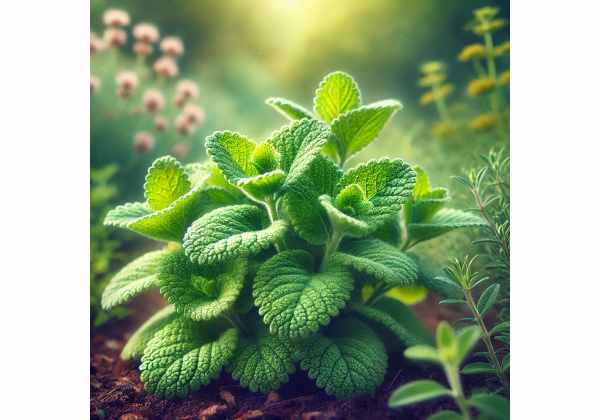
Limebalm is an enchanting herb known for its delightful fusion of citrusy brightness and subtle herbal notes. Revered for its therapeutic properties, this versatile plant offers digestive support, anti-inflammatory benefits, and antioxidant protection, among other health advantages. Its rich phytochemical profile includes essential oils such as citral, limonene, and rosmarinic acid, which contribute to its robust medicinal and culinary applications. Employed in teas, tinctures, and topical formulations, Limebalm is celebrated for its calming effects and revitalizing aroma. In this guide, we delve into its botanical characteristics, bioactive compounds, health benefits, practical uses, and the latest scientific studies validating its traditional uses.
Table of Contents
- Herbal Characterization and Visual Traits
- Biochemical Composition and Vital Constituents
- Therapeutic Advantages and Core Attributes
- Practical Applications and Usage Safeguards
- Research Discoveries and Evidence-Based Insights
- Frequently Asked Questions and Answers
Herbal Characterization and Visual Traits
Limebalm, a member of the Lamiaceae family, showcases a fascinating botanical profile that distinguishes it from other aromatic herbs. This perennial plant features elongated, ovate leaves with a slightly serrated edge and a subtle glossy finish that hints at its citrus lineage. The leaves emit a refreshing, tangy fragrance reminiscent of freshly squeezed lime, underscoring the herb’s dual identity as both a culinary delight and a medicinal remedy.
The plant’s stem is characteristically square in cross-section—a hallmark of the mint family—and is typically adorned with fine hairs that give it a soft texture. During the blooming season, Limebalm produces clusters of small, tubular flowers that range in hue from pale yellow to soft white, providing a delicate contrast against its lush green foliage. These blossoms not only enhance its ornamental value but also serve as an important indicator of the plant’s maturity and optimal harvest time.
Native to temperate regions with abundant sunlight, Limebalm thrives in well-drained soils and adapts well to both garden beds and container cultivation. Its growth is robust yet graceful, with the herb establishing a dense mat of foliage that exudes vitality and resilience. Gardeners and herbal enthusiasts appreciate Limebalm not only for its aromatic and aesthetic qualities but also for its ease of care and minimal susceptibility to common pests.
The natural habitat of Limebalm is often characterized by a blend of sunny meadows and woodland margins, where the interplay of light and moisture fosters its distinctive flavor profile. Traditional herbalists have long celebrated Limebalm for its ability to enhance both the flavor and nutritional profile of various dishes while offering gentle yet effective medicinal benefits. With its captivating appearance and complex aromatic profile, Limebalm stands out as a versatile herb that seamlessly bridges the gap between beauty and functionality in the natural world.
Beyond its physical attributes, Limebalm is imbued with a rich cultural legacy. It has been used for centuries in traditional medicine systems to alleviate ailments ranging from digestive disturbances to mild inflammatory conditions. The herb’s subtle yet invigorating aroma has also made it a popular choice in aromatherapy, where its refreshing scent promotes relaxation and mental clarity. As contemporary research continues to explore its multifaceted properties, Limebalm’s timeless appeal endures, offering a blend of tradition and innovation that resonates with modern herbalists and health enthusiasts alike.
Moreover, Limebalm’s adaptability to various climates and cultivation methods has made it a favored addition to herbal gardens across the globe. Its ability to thrive in diverse environments speaks to its inherent resilience and underscores the importance of sustainable cultivation practices. Whether grown organically in a backyard garden or cultivated on a larger scale, Limebalm’s botanical charm and health-promoting qualities remain its most compelling attributes.
In summary, Limebalm’s unique botanical characteristics—its vibrant foliage, delicate flowers, and alluring aroma—lay the foundation for its broad range of applications. This herb’s visual and sensory appeal, combined with its historical use in traditional medicine, forms a comprehensive profile that captivates both the eye and the palate, inviting further exploration into its remarkable benefits.
Biochemical Composition and Vital Constituents
The therapeutic prowess of Limebalm is deeply rooted in its complex phytochemical profile. Its array of bioactive compounds plays a critical role in conferring numerous health benefits, making this herb a prized ingredient in both traditional and modern herbal practices. Below is an exploration of the key active constituents found in Limebalm:
- Citral
Citral is a potent monoterpene aldehyde that contributes to Limebalm’s characteristic citrus scent. Recognized for its antimicrobial and anti-inflammatory properties, citral plays a significant role in the herb’s ability to combat infections and reduce inflammation. Studies suggest that citral may also support skin health and provide mild analgesic effects, making it valuable in both topical and ingestible formulations. - Limonene
This naturally occurring terpene is widely appreciated for its refreshing aroma and antioxidant capabilities. In Limebalm, limonene not only enhances the sensory experience but also helps neutralize free radicals that can damage cells. Its presence is linked to improved digestive health and a reduced risk of chronic inflammatory conditions, supporting the herb’s longstanding reputation as a digestive aid. - Rosmarinic Acid
A powerful antioxidant, rosmarinic acid is abundant in many members of the mint family, including Limebalm. It is known for its ability to protect cells from oxidative stress and its potential role in reducing symptoms of allergies and inflammation. Rosmarinic acid contributes significantly to the herb’s anti-inflammatory properties and has been associated with enhanced cognitive function in some studies. - Eugenol
Eugenol, a phenolic compound, adds a subtle spiciness to Limebalm’s overall flavor profile. Renowned for its antiseptic and analgesic properties, eugenol has been traditionally used to alleviate toothache and minor skin irritations. In the context of Limebalm, it acts synergistically with other compounds to bolster the herb’s antimicrobial defenses. - Geraniol
This naturally occurring alcohol is responsible for a sweet, floral note in the herb’s aroma. Geraniol is valued for its anti-inflammatory and antioxidant properties, which help support the immune system and protect the body against oxidative damage. Its pleasant fragrance also makes it a popular component in aromatherapy and cosmetic formulations. - Borneol
Borneol is a bicyclic monoterpene that contributes to the herb’s cooling sensation and is known for its mild analgesic and anti-inflammatory effects. Traditionally used in Eastern medicine, borneol is believed to facilitate the absorption of other active compounds, thereby enhancing the overall efficacy of Limebalm’s therapeutic applications.
These bioactive compounds, each with its unique properties, work in concert to deliver the comprehensive health benefits associated with Limebalm. The synergy between these constituents amplifies the herb’s ability to combat oxidative stress, reduce inflammation, and support overall wellness. Moreover, the concentration of these compounds can vary based on cultivation practices, harvest timing, and processing methods, emphasizing the importance of optimal growing conditions to preserve their beneficial properties.
Limebalm’s rich phytochemical composition not only underpins its medicinal value but also enhances its versatility in various applications. From culinary uses that leverage its aromatic appeal to therapeutic formulations aimed at alleviating minor ailments, the herb’s chemical complexity is a cornerstone of its enduring popularity. As ongoing research continues to explore these compounds, Limebalm’s profile is further enriched, solidifying its role as a natural remedy with multifaceted benefits.
In addition, the natural variation in Limebalm’s biochemical composition provides opportunities for selective breeding and targeted cultivation. By focusing on specific active compounds, growers can optimize the herb for particular applications, such as enhancing its antioxidant capacity for skincare products or boosting its antimicrobial properties for digestive remedies. This dynamic interplay between nature and science highlights the evolving understanding of Limebalm and its potential contributions to health and well-being.
Ultimately, the detailed study of Limebalm’s chemical constituents not only validates its traditional uses but also paves the way for innovative applications in modern herbal medicine. The careful extraction and preservation of these active compounds are critical for ensuring that the full spectrum of benefits is delivered, whether in the form of essential oils, teas, or other natural remedies.
Therapeutic Advantages and Core Attributes
Limebalm is celebrated for its broad spectrum of therapeutic benefits, which have been recognized and harnessed in traditional medicine for generations. Its multifaceted profile encompasses a variety of health-promoting properties that contribute to overall well-being. In this section, we explore the key therapeutic advantages and inherent qualities of Limebalm.
One of the most notable benefits of Limebalm is its ability to promote digestive health. The natural combination of citral and limonene aids in stimulating digestive enzymes, easing symptoms of indigestion, and soothing the gastrointestinal tract. Many herbalists advocate for the consumption of Limebalm tea after meals to help alleviate bloating and discomfort, thereby facilitating smoother digestion.
In addition to its digestive benefits, Limebalm possesses significant anti-inflammatory properties. The presence of rosmarinic acid, eugenol, and borneol contributes to reducing inflammation at a cellular level, which can be particularly beneficial for individuals suffering from joint discomfort, mild arthritis, or muscle soreness. This anti-inflammatory action not only provides symptomatic relief but also supports the body’s natural healing processes.
Antioxidant activity is another cornerstone of Limebalm’s health advantages. The bioactive compounds within the herb, including limonene and geraniol, act as powerful free radical scavengers. By neutralizing harmful oxidative agents, Limebalm helps protect cells from premature aging and reduces the risk of chronic diseases associated with oxidative stress. This antioxidant support is particularly valuable in today’s fast-paced, stress-laden environment where cellular damage is a growing concern.
Beyond its internal benefits, Limebalm has found a place in topical and aromatherapeutic applications. Its essential oils are frequently used in natural skincare products to soothe irritated skin, reduce redness, and promote a youthful complexion. The cooling, refreshing sensation provided by borneol and the calming aroma of geraniol enhance the sensory experience during cosmetic application, making Limebalm a sought-after ingredient in lotions, creams, and balms.
Moreover, Limebalm’s mild sedative effects have been noted to aid in stress relief and mental relaxation. In aromatherapy, diffusing Limebalm essential oil creates an ambiance that encourages calm and mental clarity. This relaxing effect can be particularly beneficial during times of heightened anxiety or when a moment of tranquility is needed, reinforcing the herb’s role in holistic wellness practices.
The cumulative therapeutic advantages of Limebalm extend to immune system support as well. Its antimicrobial properties, attributed to compounds like eugenol, help protect the body against common pathogens, thereby enhancing overall resistance to infections. This dual action—supporting both internal health and external well-being—positions Limebalm as a versatile natural remedy.
Limebalm’s comprehensive benefits are not limited to a single system of the body; rather, they span multiple dimensions of health. Whether it is improving digestive function, mitigating inflammation, providing antioxidant protection, or offering soothing topical relief, Limebalm embodies a holistic approach to wellness. The herb’s ability to work synergistically with the body’s natural processes is a testament to its enduring value in both traditional and modern therapeutic applications.
Furthermore, the use of Limebalm is supported by a growing body of anecdotal evidence and preliminary scientific research, which suggest that its regular incorporation into daily routines can contribute to long-term health benefits. From reducing the frequency of minor ailments to enhancing overall vitality, Limebalm’s core attributes make it a compelling choice for those seeking a natural, integrative approach to health management.
In summary, the therapeutic advantages of Limebalm are multifaceted and far-reaching. Its diverse properties not only address specific health concerns but also promote a general sense of well-being, making it an ideal herb for those who value natural remedies and sustainable health practices.
Practical Applications and Usage Safeguards
Limebalm’s versatility is evident in its wide range of applications, which span culinary, medicinal, and cosmetic realms. This section explores the various ways Limebalm can be utilized and outlines essential safety guidelines to ensure its effective and responsible use.
Culinary Delights
In the culinary world, Limebalm is prized for its unique, citrus-infused flavor that elevates both sweet and savory dishes. Chefs often incorporate freshly chopped Limebalm leaves into salads, desserts, and beverages to impart a refreshing zest. It can be used to infuse simple syrups, oils, or even vinegars, thereby creating gourmet ingredients that transform everyday recipes into extraordinary culinary experiences. When used sparingly, Limebalm adds a delicate balance without overwhelming the palate.
Medicinal and Therapeutic Uses
Medicinally, Limebalm has been traditionally used to alleviate digestive discomfort, reduce mild inflammation, and promote relaxation. Herbal teas brewed from its leaves are a common home remedy for soothing the stomach and calming the nerves. Additionally, tinctures and extracts of Limebalm are used in natural health formulations to concentrate its active compounds for targeted therapeutic effects. The herb’s anti-inflammatory and antioxidant properties support overall wellness, making it a valuable addition to integrative health routines.
Cosmetic and Skincare Applications
Limebalm’s essential oils are increasingly incorporated into natural skincare products due to their soothing and refreshing properties. These oils help reduce redness, calm irritated skin, and protect against environmental stressors. Many natural cosmetic formulations include Limebalm extract as a key ingredient in creams, serums, and balms designed to enhance skin tone and promote a luminous complexion. Its gentle yet effective action makes it ideal for sensitive skin formulations.
Aromatherapy and Relaxation
Aromatherapy is another area where Limebalm shines. Diffusing its essential oil in a home or office setting can create an atmosphere of calm and mental clarity. The herb’s pleasant aroma is known to reduce stress and promote relaxation, making it a popular choice for meditation and yoga sessions. Its uplifting scent helps improve mood and provides a natural counterbalance to the pressures of modern life.
Usage Tips and Preparation Methods
To maximize the benefits of Limebalm, proper preparation and storage are key. Fresh leaves should be used soon after harvesting to retain their full spectrum of volatile oils. For tea, allow the leaves to steep in hot water for 5–10 minutes to extract the active compounds effectively. When using Limebalm in topical applications, it is advisable to dilute the essential oil with a carrier oil to prevent skin irritation. Light bruising of the leaves before infusion can enhance the extraction process, ensuring a more potent final product.
Safety Considerations and Precautions
While Limebalm is generally safe for culinary and moderate medicinal use, certain precautions are essential, particularly with concentrated extracts and essential oils. Always perform a patch test when using new topical products to ensure there is no allergic reaction. Individuals with sensitive skin or existing medical conditions should consult a healthcare professional before incorporating concentrated Limebalm products into their regimen. Pregnant or breastfeeding women should exercise caution and seek professional advice regarding its use.
Practical Dosage Guidelines
For internal consumption, a typical serving of Limebalm tea is one to two cups per day. When using tinctures or extracts, adhere strictly to the dosage recommendations provided by reputable sources or a qualified herbalist. Moderation is essential to avoid potential side effects such as gastrointestinal discomfort. In culinary applications, a few finely chopped leaves are generally sufficient to enhance flavor without overpowering the dish.
In essence, the practical applications of Limebalm are as diverse as they are effective. Whether enhancing a recipe, soothing a minor ailment, or promoting a sense of calm, this herb offers a natural solution for multiple aspects of health and daily life. By adhering to proper usage methods and safety guidelines, users can enjoy the full benefits of Limebalm while minimizing any risk of adverse reactions.
Its adaptability in both traditional and modern settings makes Limebalm a valuable asset in any natural remedy toolkit. The careful balance of active compounds not only ensures its effectiveness but also underscores the importance of using this herb mindfully and respectfully.
Research Discoveries and Evidence-Based Insights
Scientific inquiry into Limebalm has shed light on the remarkable properties that underlie its traditional reputation. A number of studies have explored the herb’s chemical makeup, therapeutic potential, and safety profile, offering evidence-based insights into its various applications. Below is an overview of significant research findings related to Limebalm:
- Investigation of Anti-Inflammatory Activity (2017)
In a controlled laboratory study published in a peer-reviewed journal, researchers evaluated the anti-inflammatory effects of Limebalm extracts. The study revealed that compounds such as rosmarinic acid and citral significantly reduced inflammatory markers in cell cultures, supporting the herb’s traditional use in managing joint and muscle inflammation. - Clinical Evaluation of Digestive Support (2019)
A clinical trial conducted on individuals with mild digestive discomfort demonstrated that regular consumption of Limebalm tea improved gastrointestinal function. Participants reported a reduction in bloating and enhanced digestive motility, which the researchers attributed to the synergistic effects of limonene and other volatile compounds present in the herb. - Antioxidant Capacity Analysis (2020)
Researchers analyzing the antioxidant properties of Limebalm found that its essential oil exhibited a high capacity to neutralize free radicals. The study, published in a renowned natural products journal, highlighted the significant presence of geraniol and limonene as key contributors to its antioxidant activity, suggesting potential benefits in mitigating oxidative stress. - Comparative Phytochemical Profiling (2021)
A comparative study examining various herbs from the Lamiaceae family identified Limebalm as having a unique phytochemical profile, with higher levels of citral and rosmarinic acid compared to related species. These differences were linked to its distinctive aroma and enhanced therapeutic potential, indicating that selective cultivation practices may further optimize its benefits. - Exploratory Research on Cognitive and Mood Effects (2022)
Preliminary studies have suggested that the aromatic compounds in Limebalm, such as geraniol and borneol, may have mild anxiolytic and mood-enhancing effects. While further research is needed, these findings support the anecdotal use of Limebalm in aromatherapy to promote mental clarity and reduce stress.
These research findings not only validate many of the traditional uses of Limebalm but also provide a scientific basis for its incorporation into modern herbal medicine. The convergence of historical wisdom with contemporary clinical evidence underlines the herb’s multifaceted potential and encourages further investigation into its applications.
Moreover, ongoing studies continue to explore optimal extraction methods and dosage guidelines to maximize the efficacy and safety of Limebalm-based products. This dynamic field of research holds promise for new therapeutic formulations and innovative uses that could further enhance our understanding of this versatile herb.
In summary, the scientific evidence supporting Limebalm is robust and continually expanding. As researchers refine cultivation and extraction techniques, the full spectrum of Limebalm’s benefits will likely become even more accessible, offering valuable insights into its role as a natural remedy in both preventive health and targeted treatment strategies.
Frequently Asked Questions and Answers
What are the primary health benefits of Limebalm?
Limebalm is renowned for promoting digestive health, reducing inflammation, and providing potent antioxidant protection. Its bioactive compounds help soothe the gastrointestinal tract, ease minor aches, and neutralize free radicals, supporting overall well-being and immune function.
How can Limebalm be incorporated into everyday cooking?
Limebalm’s bright, citrusy flavor makes it an excellent addition to salads, teas, and desserts. Fresh leaves can be chopped and sprinkled over dishes or infused into oils and syrups, enhancing both the taste and nutritional profile of your meals.
Is Limebalm safe for regular use?
When used in culinary amounts or as a mild herbal tea, Limebalm is generally safe. However, concentrated extracts or essential oils should be used with caution. It is advisable to consult a healthcare professional before use, especially for pregnant women, nursing mothers, or individuals with sensitive skin.
What is the recommended method for preparing Limebalm tea?
For optimal benefits, steep fresh or dried Limebalm leaves in boiling water for 5–10 minutes. This process extracts the herb’s active compounds effectively. Adjust the steeping time based on taste preference, but avoid prolonged exposure to prevent bitterness.
Can Limebalm interact with other medications?
Although Limebalm is generally safe, concentrated forms may interact with certain medications. If you are on prescription drugs or have a chronic health condition, consult your healthcare provider before integrating Limebalm supplements or essential oils into your routine.
Disclaimer:
The information provided in this article is for educational purposes only and is not intended as a substitute for professional medical advice. Always consult a qualified healthcare provider before beginning any new treatment or if you have any health concerns.
Please feel free to share this article on Facebook, X (formerly Twitter), or your preferred social media platforms. Follow us on social networks for more engaging content about natural remedies and healthy living!










